This post is an update on my experiments measuring the effect of low-carb foods and dietary supplements on blood sugar.
This week, I have the results from low-carb cereals. Next week I’ll be posting results from my sleep study, followed by low-carb ice-creams.
Testing Queue:
- Baseline:
- Glucose re-test: In queue
- Low-carb foods:
- Meal replacements: 2/3 complete, (Ketochow previously reported)
- Flour replacements: 1/4 complete
- Tortilla: Reported
- Bread: 2/10 complete
- Snack bars: 0/8 complete
- Ice cream: 5/11 complete
- Cereals: This post
- Supplements:
- Vinegar: In queue
- MSG: Reported
Cereals
Summary:
I tested 7 low-carb cereals from 3 categories (nut & seed granolas, milk protein & sweetener blends, and protein & fiber blends).
The granolas had the lowest blood glucose impact by weight (~7% & ~15% of glucose for peak BG/g & iAuC/g). By volume, though, all except Catalina Crunch were very similar.
The highest blood glucose by a wide margin was Catalina Crunch, a protein and fiber blend, with at 28% & 62% of glucose for peak BG/g & iAuC/g. This likely stems from its use of potato and corn fiber, which are digestible despite being subtracted for the net carb count.
On taste, all the cereals were good, but sweeter than I’d like (see Table above). Of the granolas, my favorite was the NuTrail, which had a strong cinnamon & vanilla flavor that paired well with the pecans, pumpkin seeds, and coconut. Of the more cereal-like cereals, my favorite by far was the Magic Spoon. The texture was shockingly like regular cereal and it was the only one of the bunch that didn’t taste strongly of the non-nutritive sweetener. For these experiments, I used the banana, but a tried a few of their other flavors and liked them a lot more (my favorite was maple).
Compared with the tortillas, I didn’t get as much direct value out of these measurements. While I liked the cereals, they’re too sweet and too low in nutrition for me to use for regular meals and keeping them around is too much of a temptation to break my diet. I might get a box every once in a while as a treat, but I won’t be incorporating them in to my regular rotation.
Does anyone know any other good low-carb cereals I should try?
Details:
Purpose
- To identify low-carb foods that taste good and have minimal effect on my blood glucose.
- To determine the effect of popular, literature supported dietary supplements on my blood glucose.
Background
Before I got diabetes, my favorite breakfast was a bowl of cereal with milk. In the last few years, a ton of new brands of low-carb cereals come out, with some even available in supermarkets (some popular press articles here and here).
Although the net carb counts look good, I’ve become very suspicious of the blood sugar impact of some of the dietary fibers used (see evidence of blood glucose impact of dietary fibers here & here).
To see if any of available low-carb cereals would hold up, I decided to test them myself.
Design/Methods
Foods
I tested 7 low-carb cereals from 3 different categories:
- Nut- & seed-based granolas
- Milk protein & sweetener blends
- Protein & fiber blends
Full nutrient and ingredient info here. Key nutrition facts in the table below.
Procedure
At 5:00a, I took 4.5u of Novolog (fast acting insulin, duration of 2-4h), then drank a Ketochow shake (website, BG testing) at 5:30a. After that, no food or calorie-containing drinks were consumed and no exercise was performed. Non-calorie-containing drinks were consumed as desired (water, caffeine-free tea, and decaffeinated coffee). At 11am-12 pm, the substance to be tested was eaten as rapidly as comfortable and notes on taste and texture were recorded (before observing any change in blood sugar).
Blood sugar was monitored for 5h using a Dexcom G6. Calibration was performed 15-30 min. before the start of each experiment.
Data Processing & Visualization. iAUC was calculated using the trapezoid method (see data spreadsheet for details). Data was visualized using Tableau.
Medication. During these experiments, I took long-acting basal insulin each evening at 9pm (Lantus, 1.52u) and 2000 mg of metformin and multivitamin each morning at 5am. I did not dose for the experimental food ingested.
Data
- Formatted raw data, peak blood glucose, iAuC, and time to peak data
- Summary data, ingredient details, and taste assessments
Results & Discussion
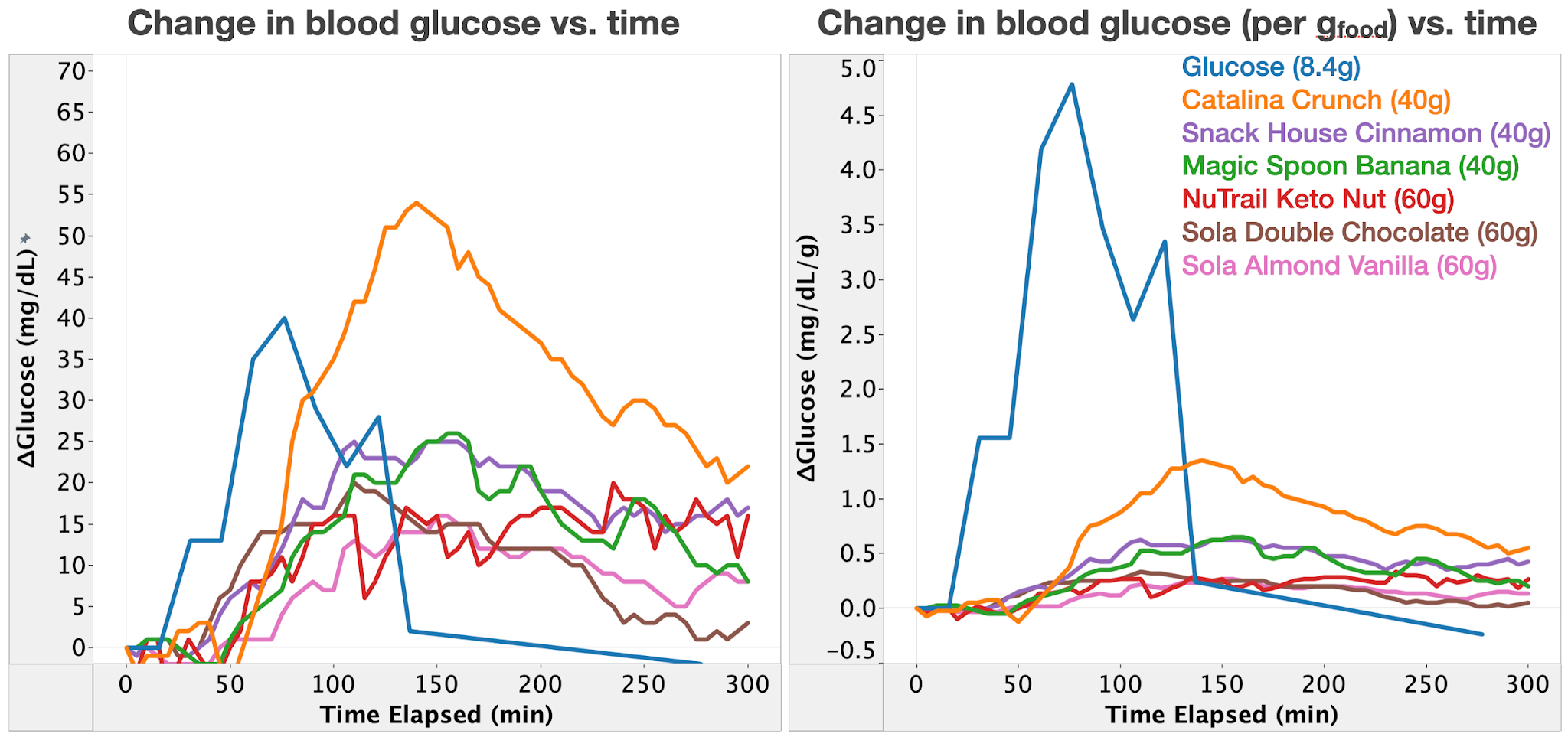 |
| Figure 1. Left – Change in blood glucose vs. time. Right – Change in blood glucose per g(food) vs. time |
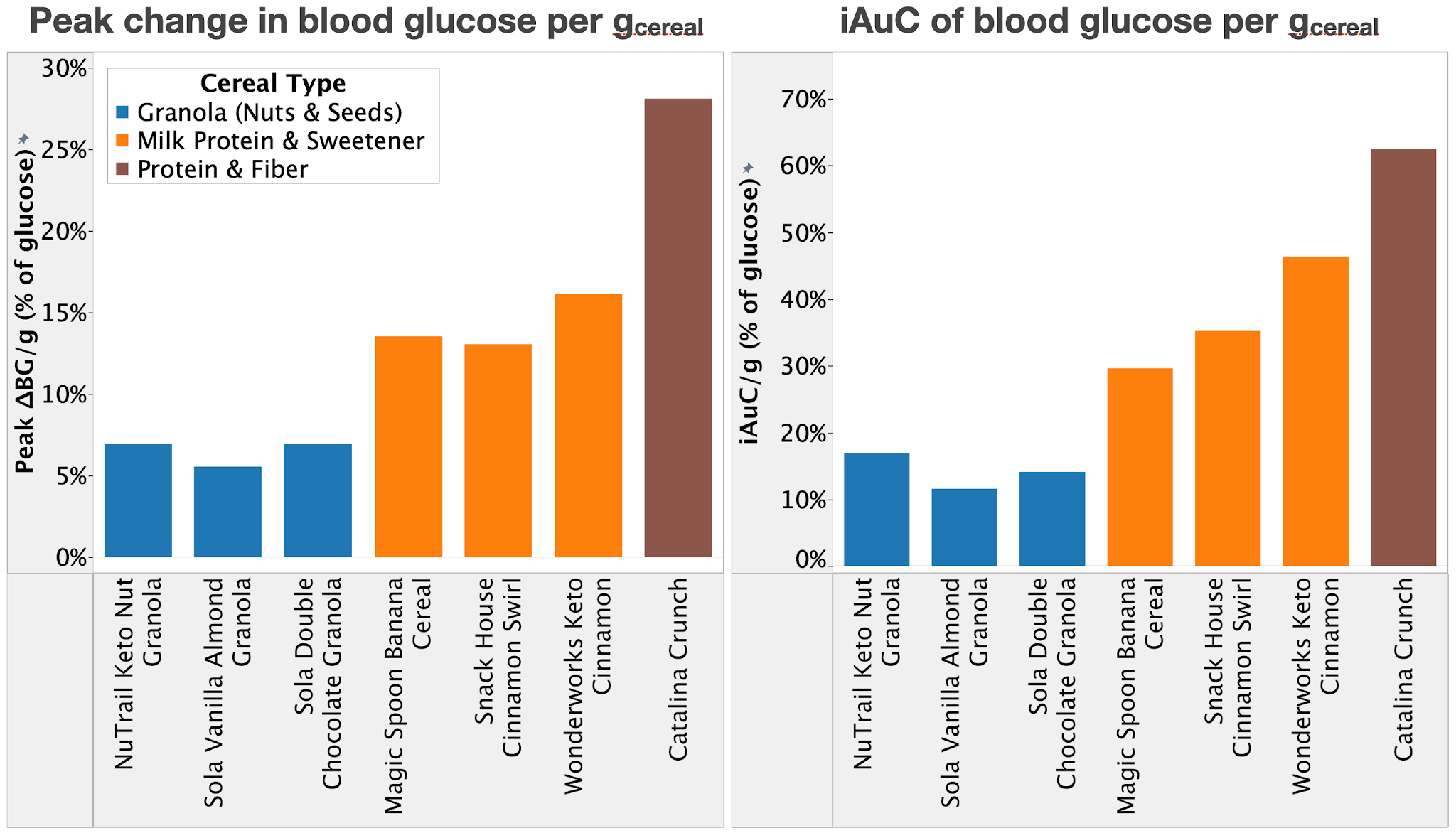 |
| Figure 2. Left – Peak change in blood glucose per g(food). Right – iAuC per g(food). All values reported as % of the value measured for glucose. |
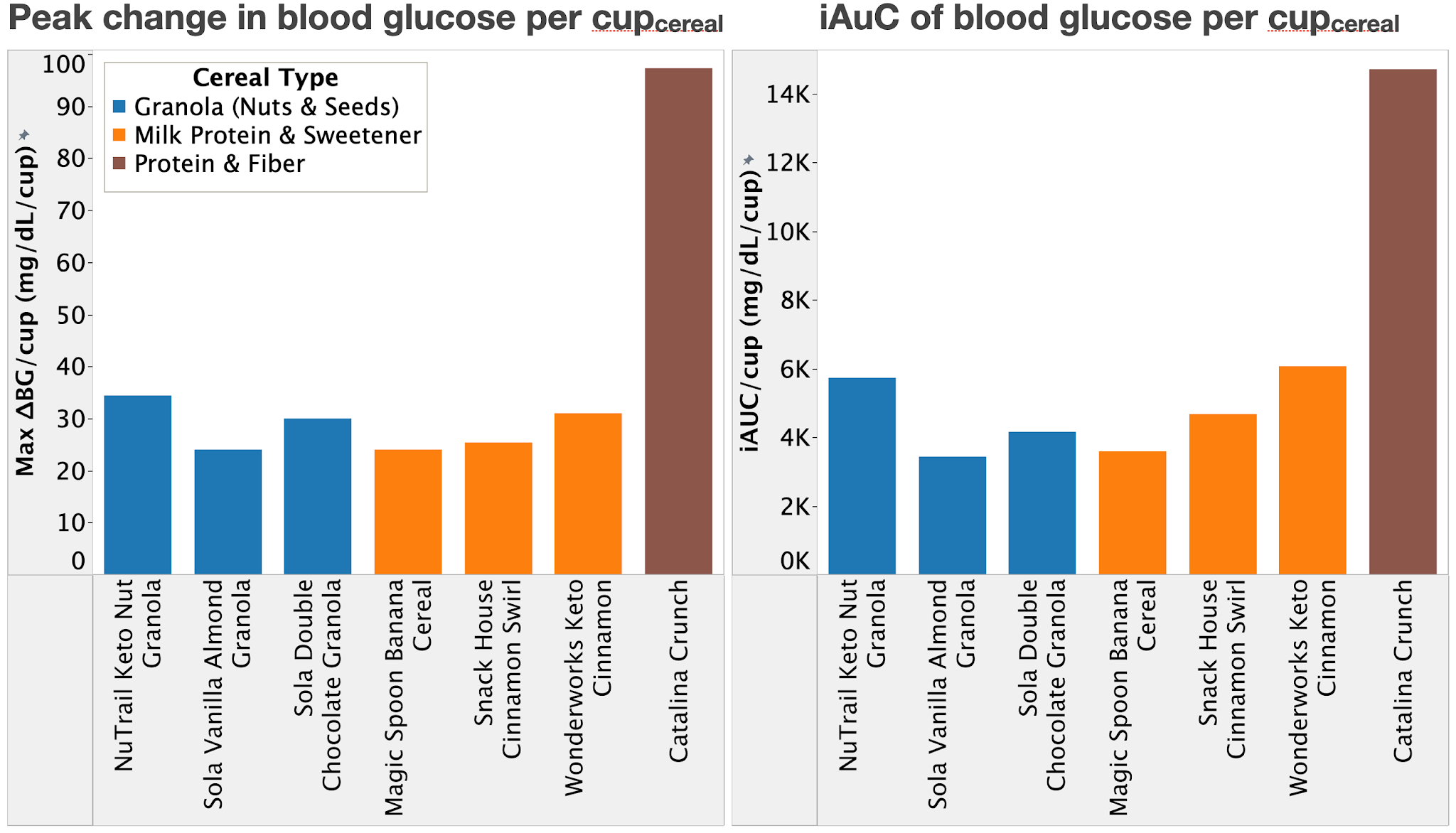 |
| Figure 3. Left – Peak change in blood glucose per cup(food). Right – iAuC per cup(food). |
Changes in blood glucose as a function of time are shown in Figure 1. All cereals show a longer time to initial rise, less steep rise, and longer duration of impact than glucose, consistent with a slower absorption and metabolism. This profile is consistent with a mix of protein, starches, and a higher fat content.
There was a dramatic difference in the blood glucose impact of the different types of cereals by weight. The nut and seed granolas showed the lowest impact at ~7% & ~15% of glucose for peak BG/g & iAuC/g. The milk protein and sweetener blends were about twice that at ~15% & ~35% of glucose. The worst of the bunch was Catalina Crunch, a protein and fiber blend at 28% & 62%. It looks like the fibers it uses (potato fiber, corn fiber) have a significant impact despite being subtracted for the net carb count.
The different types of cereals also had significantly different densities. Depending on whether your goals and preferences, you may care more about the impact of a volume of cereal instead of weight. Personally, I tend to eat a full bowl of cereal in a sitting (~1 cup), so that’s what I care about. When you normalize by volume, the differences between the granolas and the milk protein & sweetener cereals goes away, though Catalina Crunch is still much higher impact than everything else.
On taste, all the cereals were good, but sweeter than I’d like (see Table above). Of the granolas, my favorite was the NuTrail, which had a strong cinnamon & vanilla flavor that paired well with the pecans, pumpkin seeds, and coconut. Of the more cereal-like cereals, my favorite by far was the Magic Spoon. The texture was shockingly like regular cereal and it was the only one of the bunch that didn’t taste strongly of the non-nutritive sweetener. For these experiments, I used the banana, but a tried a few of their other flavors and liked them a lot more (my favorite was maple).
Note: taste and texture observations were recorded when I ate the food. I.e. before I knew its impact on my blood sugar.
Thoughts & Next Experiments
The food effect studies continue to go well. I’m still seeing very large differences in blood glucose impact, independent of the carb count, bolstering the conclusion that the digestibility of fibers varies widely. After I collect more data, I plan to go back and see if I can find a better metric than net carbs to predict the impact of a given food.
Compared with the tortillas, I didn’t get as much direct value out of these measurements. While I liked the cereals, they’re too sweet and too low in nutrition for me to use for regular meals and keeping them around is too much of a temptation to break my diet. I might get a box every once in a while as a treat, but I won’t be incorporating them in to my regular rotation.
Does anyone know any other good low-carb cereals I should try?
As always, please let me know if you have any thoughts or suggestions.
– QD
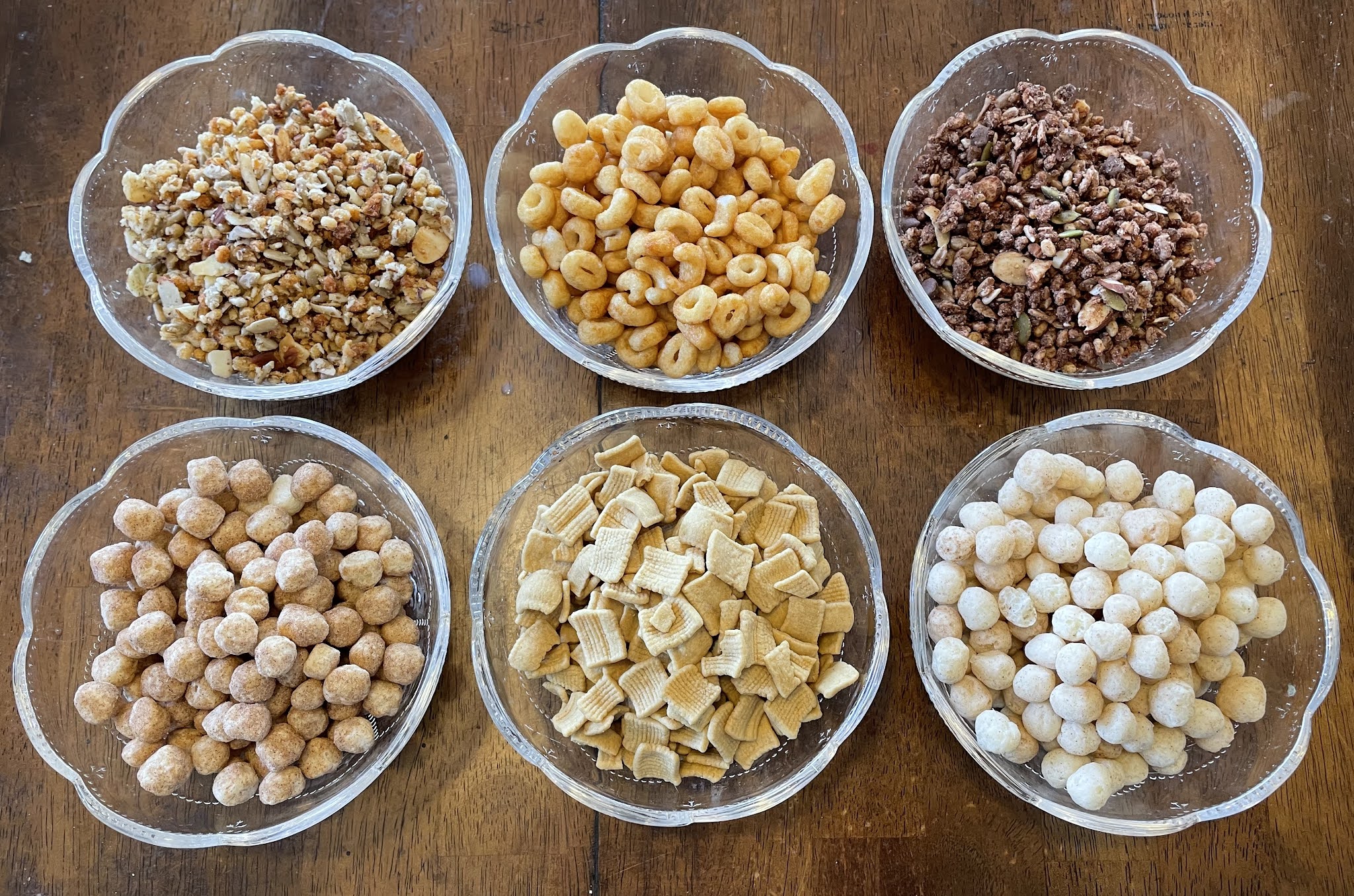
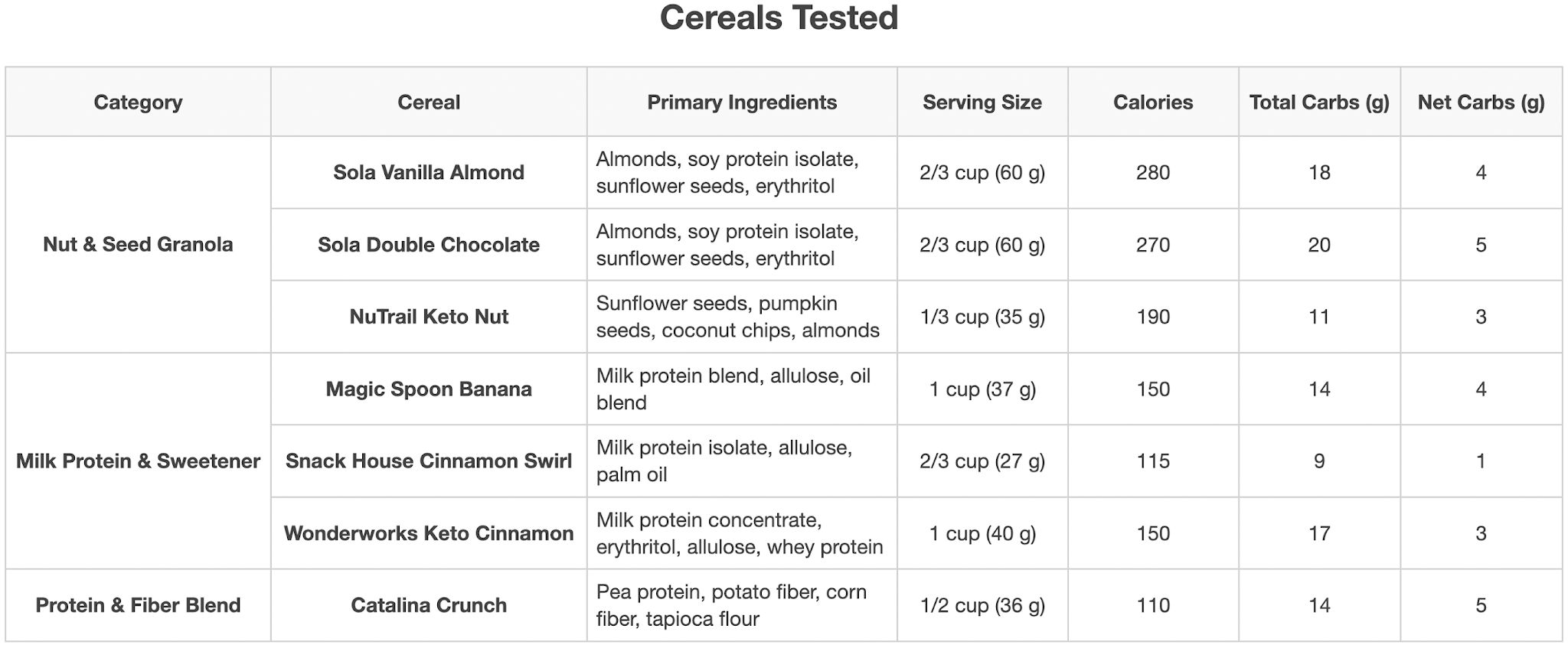
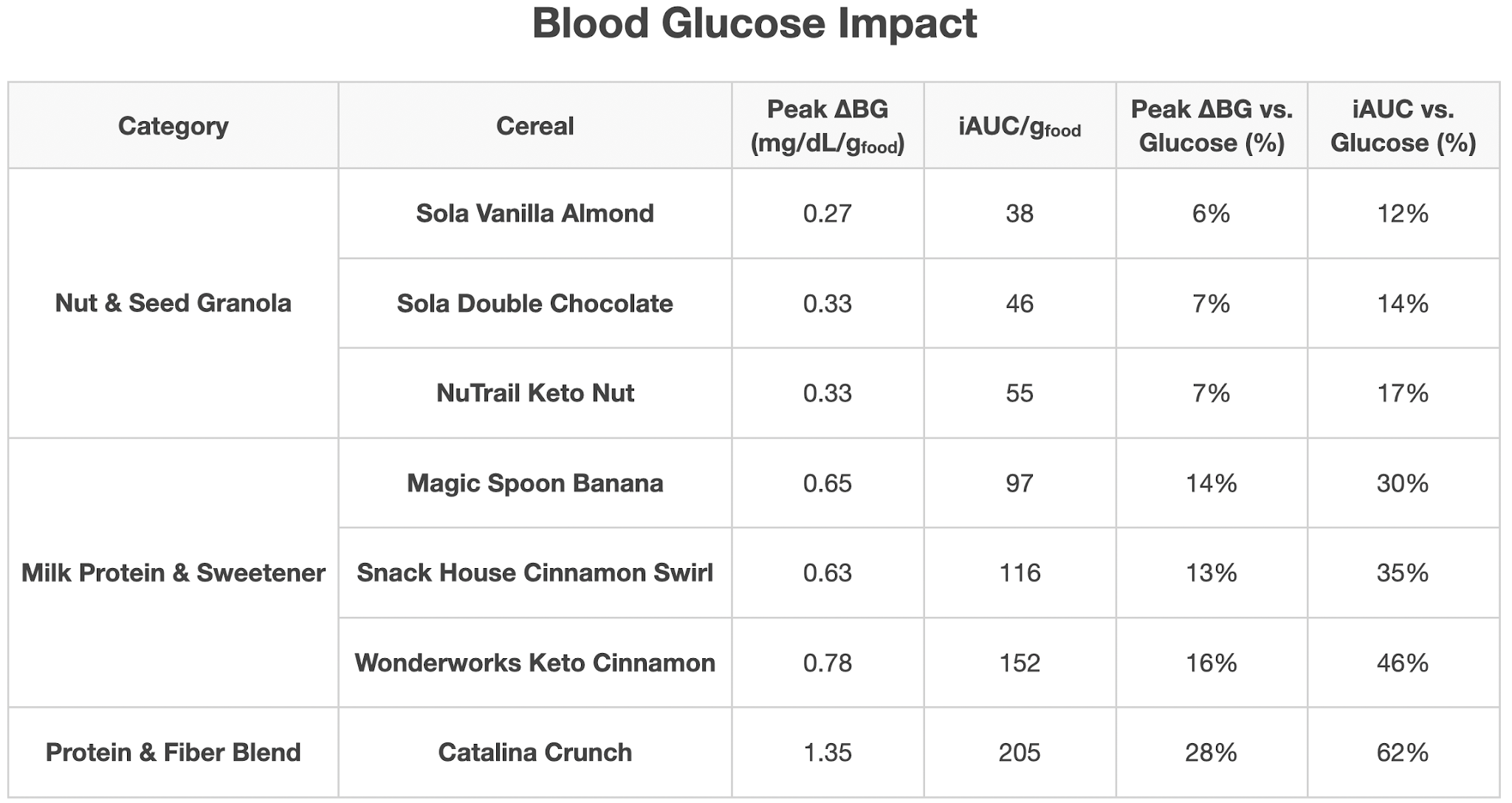
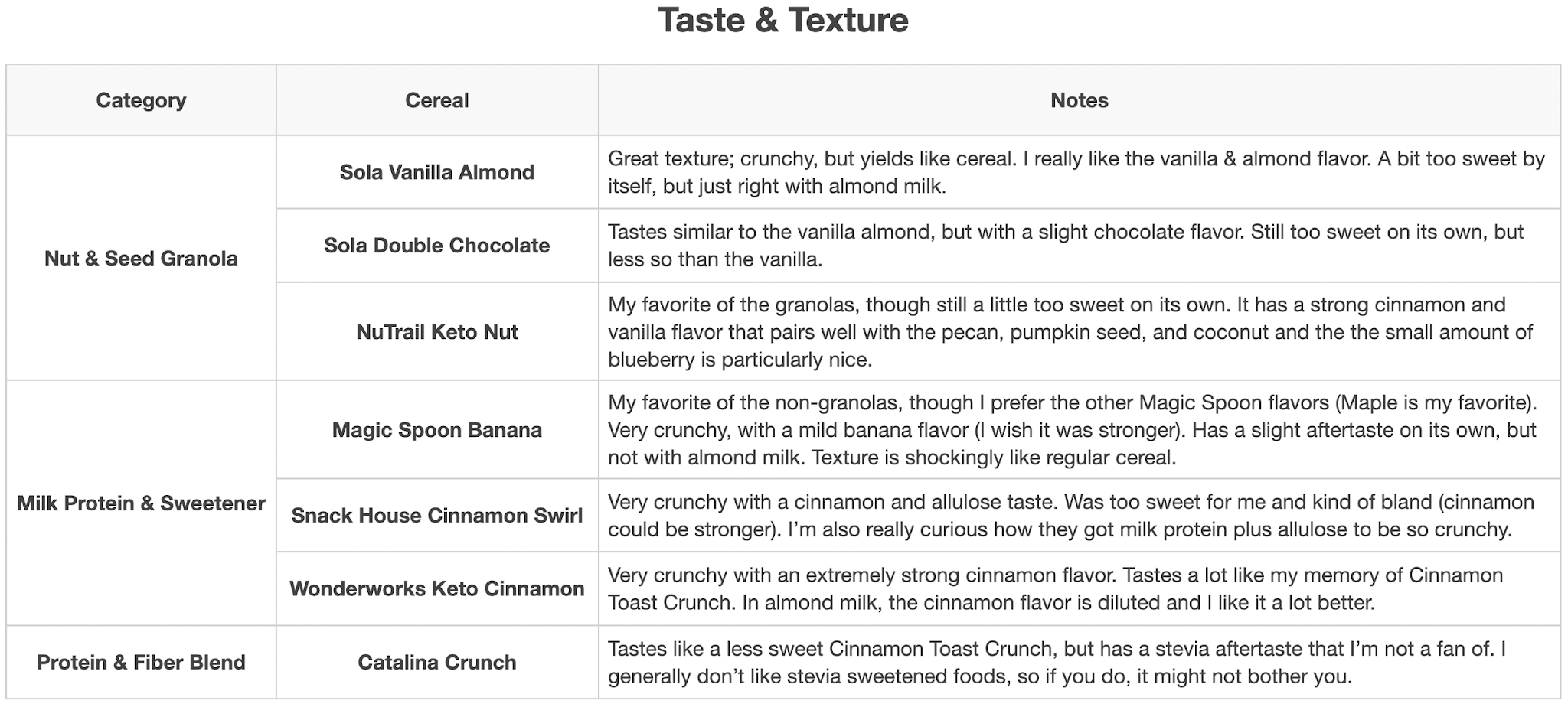
Thanks for your info. I am beyond annoyed because at this point all of the “net carb” information is just dishonest labeling. I thought I’d found a miracle cereal with Catalina Crunch and it’s most likely the reason I can’t lose weight because I’ve been eating it every day. So much time wasted thinking I was eating a tiny amount of carbs!
Have you ever tested the Atkins shakes or bars? I avoid a lot of them because of ingredients like maltodextrin but I’d be genuinely interested in if that’s what’s stalling my weight loss as well since I do have a couple shakes every day.
The Atkins products are hit or miss. The shakes have pretty low BG impact, with my testing showing them as having same BG impact you’d expect from the net carb count (i.e. the majority of the fiber is actually non-digestible). Some of the bars are ok, but others use digestible fibers like polydextrose that will impact blood sugar, though less so than sugar or starch. Personally, I have the Dark Chocolate Royale shake occasionally, but stay away from all the bars.
Thank you for this very useful information! I appreciate the time and effort you put into this, as well as the very detailed results! I am on WW and an following a low carb-low sugar plan and have been eating one dry cup of Catalina Crunch (CC) every night, thinking that it would be OK. So, I was shocked to find that my fasting BG had elevated to 115–Much higher than ever. Now I’m wondering if I stop the CC how long it will take for my BG to get back to normal. I Love CC, but it seems like I’ll need to back off of that and try Nutrail 0r Sobo granola instead. The Wonderworks cereal isn’t bad as a snack but not as good as CC. I am not on social media, so is there some other way I can follow your posts? Thanks again for this great information and the work you put into it.
Sorry for the late reply, I got really busy with work and haven’t posted in a while. I’m getting back into it again, though, so if you want to follow via e-mail, you can subscribe via this link: https://follow.it/quantified-diabetes?action=followPub (it’s also at the top and bottom of most posts).
P.S. to my post above, I am borderline and trying to control my BG to stay outside of the diabetes diagnosis. My mother was a Type 1 diabetic, so I have always watched my numbers. Thanks again!
we’ve had horrible results with Catalina crunch too. It raises my daughter’s BG up to 100 mg/dL! Sad as it’s made by a diabetic …
Thank you for the above information. I thought all net carbs foods were equal, but I guess not because the Catalina crunch spikes my blood sugar.
Going to test these myself. I called Catalina Crunch and asked about the amount of the third ingredient listed … Tapioca Flour, and they wouldn’t tell me. The Floor is worse than eating plain sugar. And to think the owner touts herself as coming up with brand because she is diabetic